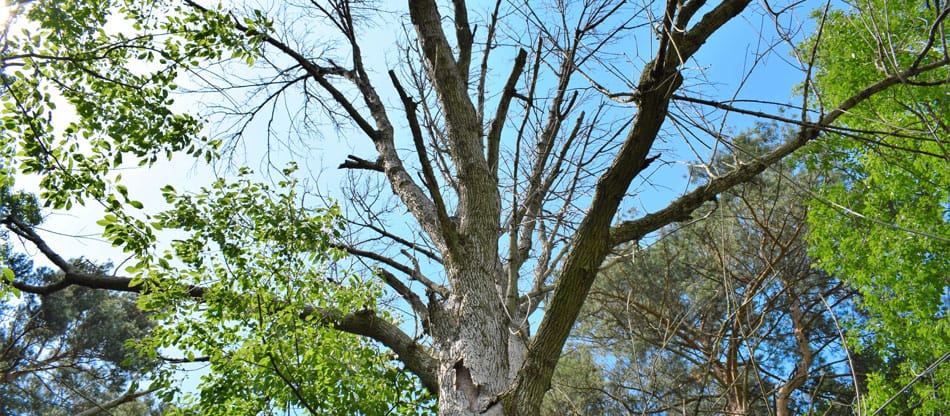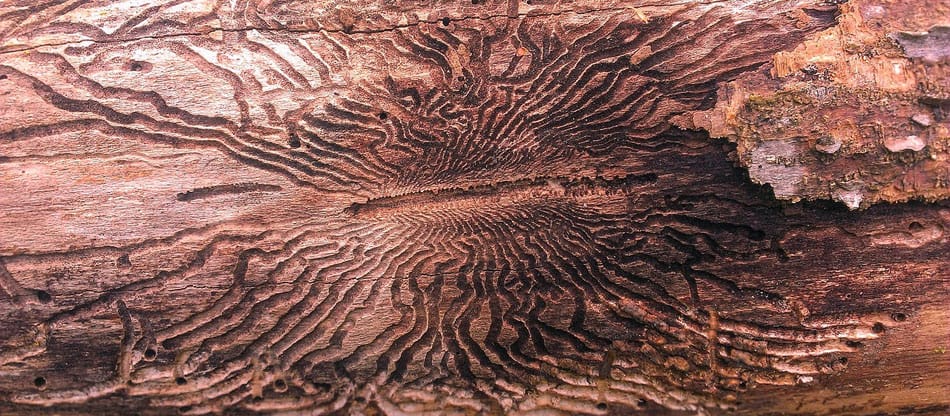
Removing Dead Ash Trees: Not a DIY Job!
The emerald ash borer (EAB) has been infesting and killing ash trees in central New Jersey and eastern Pennsylvania for several years, leaving behind acres of dead and dying trees.
We normally find that all untreated ash trees in a community will be dead within 5 to 10 years after EAB has been found there.
Emerald Ash Borer Resources
Why Dead Ash Trees Are So Dangerous
Ash trees begin to weaken almost from the time they are first infested with emerald ash borer. The EAB feeds on sapwood just under the bark (this is where you’ll notice the distinctive “gallery” left by their feeding). In doing so, it cuts off the flow of water and nutrients from the roots to the crown of the tree, resulting in dieback of the tree canopy.

EAB feeding gallery under the bark of a dead ash tree
While some dead trees remain structurally sound for years, ash trees do not. Over time, branches start to die, becoming brittle and dangerous. Eventually, the whole tree “dries out” and the wood starts to break apart. Large branches fall off. The entire top can break off, leaving just a jagged trunk, or the tree will topple over.
These trees are unstable, dangerous and unpredictable.
In (sub)urban areas, these dead trees are at high risk of becoming a significant hazard to the structures and people around them. Although dead ash trees in wooded settings can be left to fall apart, that’s not a reasonable option for trees in populated areas.
Dead ash trees that have been killed by EAB should be removed as soon as possible. This is not a DIY job!
What To Do About Dead Ash Trees
The only reasonable option for an EAB-killed ash tree on your property is to have it professionally removed ASAP.
As the landowner, it is your responsibility to remove it before it is deemed a “hazard tree” (some municipalities will even require you to do so) and many insurance companies will not cover damages caused by a dead ash tree that hasn’t been removed (on the grounds that the homeowner was negligent in not removing it).
Given the dangerous nature of these trees, removal should always be left to tree care professionals. Even then, not all companies are able or willing to remove the tree.
Tree Removal Options
Tree removal often involves having a tree care professional climb the tree to remove it piece by piece. However, because dead ash trees are so brittle and unstable, it’s often not possible to safely climb them. For that reason, some professional tree companies will choose not to do the work.
This leaves two removal options – dropping the entire tree or removing it with the help of a bucket truck, crane or spider lift.
Felling the tree has two problems. First, the trunk can be compromised, making it very difficult to safely and accurately drop the tree where you want it. Second, if there are wires, other trees or structures in the way, it may not be possible to find space in which to fell the tree without crushing whatever is beneath it.
Overall, the quickest, safest, and most cost-effective removal method for dead ash trees is to use a portable lift. This specialized piece of heavy equipment is compact enough to access most properties (for example, our spider lift will fit through a 36-inch gate) and tall enough to let the tree care worker remove an entire tree, branch by branch, without exposing them to the risk of climbing a compromised tree.
While professional tree removal comes at a cost, leaving a dead ash tree in place will likely have a higher cost in the long term. The longer you wait, the more dangerous the tree becomes, the more expensive the removal process, and the higher the risk of injury or damage caused by the tree.
